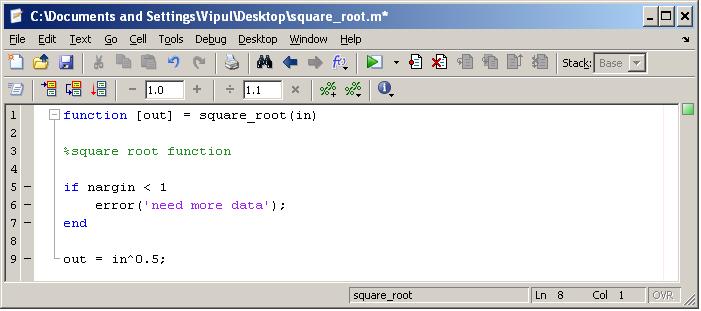

This cookie is set by GDPR Cookie Consent plugin. The cookies is used to store the user consent for the cookies in the category "Necessary". The cookie is used to store the user consent for the cookies in the category "Other.

The cookie is set by GDPR cookie consent to record the user consent for the cookies in the category "Functional". The cookie is used to store the user consent for the cookies in the category "Analytics". These cookies ensure basic functionalities and security features of the website, anonymously. Necessary cookies are absolutely essential for the website to function properly. Discount can only be availed during checkout.

MATLAB SQUARE ROOT CODE
To avail the discount - use coupon code BESAFE when checking out all three ebooks. Note: There is a rating embedded within this post, please visit this post to rate it.ģ0% discount when all the three ebooks are checked out in a single purchase. □ Impulse response and frequency response of PR signaling schemes Implementing a Matched Filter system with SRRC filtering.□ Square-root raised-cosine pulse shaping Discrete-time model for a system with pulse shaping and matched filtering.Topics in this chapter Pulse Shaping, Matched Filtering and Partial Response Signaling Rate this article: ( 2 votes, average: 4.50 out of 5) Michael Joost, Theory of root-raised cosine filter, Research and Development, 47829 Krefeld, Germany, EU, Dec 2010.Title('Frequency response (at Tx/Rx only)') legend(legendString) References Title('Combined response of SRRC filters') legend(legendString) Hold on legendString=strcat('\beta =',num2str(beta) ) i=i+1 Plot(F,abs(vals)/abs(vals(length(vals)/2+1)),lineColors(i)) =freqDomainView(srrcPulseAtTx,Fs,'double') %See Chapter 1 for the function 'freqDomainView' Plot(t,combinedResponse/max(combinedResponse),lineColors(i)) Subplot(1,2,1) t=Tsym*t %translate time base & normalize reponse %Combined response matters as it hits 0 at desired sampling instantsĬombinedResponse = conv(srrcPulseAtTx,srrcPulseAtRx,'same') SrrcPulseAtRx = srrcPulseAtTx %Using the same filter at Rx =srrcFunction(beta,L,Nsym) %SRRC Filter at Tx LineColors= i=1 legendString=cell(1,4) įor beta=betas %loop for various alpha values Nsym = 80 %filter span in symbol durationsīetas= %root raised-cosine roll-off factors L=10 % oversampling rate, each symbol contains L samples

Program 2: test_SRRCPulse.m: Square-root raised-cosine pulse characteristics Tsym=1 %Symbol duration in seconds Matlab code for Program 1 is available is available in the book Wireless Communication Systems in Matlab (click here). Program 1: srrcFunction.m: Function for generating square-root raised-cosine pulse (click here) Note that the combined impulse response of two SRRC filters is same as the impulse response of the RC filter. This indicates that the job of ISI cancellation is split between transmitter and receiver filters. The combined impulse response matters, as we can identify that the combined response hits zero at symbol sampling instants. It is followed by a test code that plots the combined impulse response of transmit-receive SRRC filter combination and also plots the frequency domain view of a single SRRC pulse as shown in Figure 1 A function for generating SRRC pulse shape is given next.


 0 kommentar(er)
0 kommentar(er)
